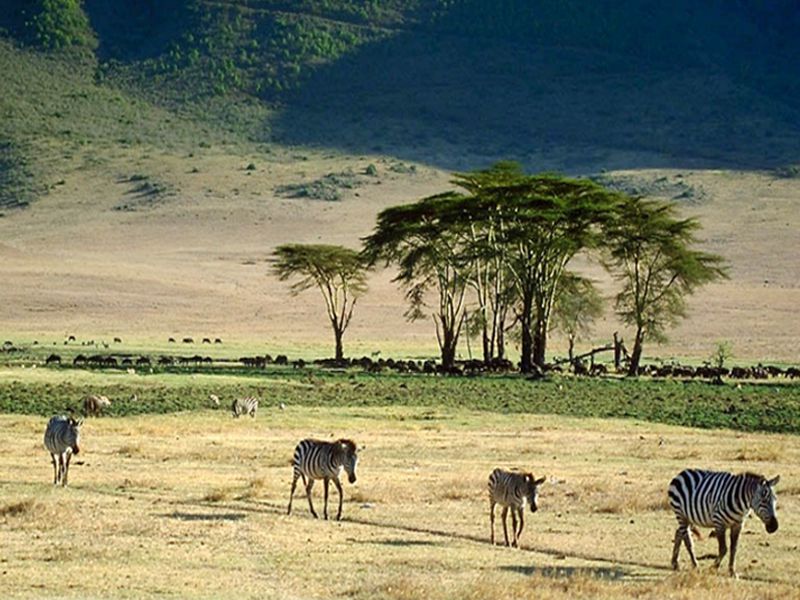
Includes also: NP Arusha, NP Tarangire, Grumeti River, Olduvai Gorge, Ngorongoro, NP Lake Manyara
10 Nights 11 Days
Day 1: Arusha National Park
After breakfast we drive to Arusha National park for some game viewing and some relaxed game walking. This beautiful park is located only 32 km (20 mi) northeast of Arusha. It covers an area of 137 sq km's (58 sq mi) and is known as "Serengeti ndogo" meaning "little Serengeti". The peaks of Mt Kilimanjaro and Mt Meru surround the park and can be seen on a clear day. The black and white colobus monkey is the park's mascot and can been seen swan-diving from branch to branch. The park also contains blue monkeys, olive baboons, elephants, hippo, leopard, hyena, zebra and antelope. The park is famous for it's 400 species of migrant and resident birds. Stay overnight at Kibo Palace in Arusha.
Day 2: Tarangire National Park
After breakfast we drive to Tarangire National Park for some very rewarding game drives. Tarangire National Park has some of the highest population density of elephants anywhere in Tanzania, and its sparse vegetation, strewn with baobab and acacia trees, makes it a beautiful and special location. Before the rains, droves of gazelle, wildebeest, zebra, and giraffes migrate to Tarangire National Park’s scrub plains where the last grazing land still remains. Stay overnight at Tarangire safari lodge.
Day 3: Tarangire National Park
We start our day with an early morning game drive around Tarangire National Park. Breathtaking views of the Masaai Steppe and the mountains to the south make a stop at Tarangire a memorable experience. We can relax by the pool in the afternoon and enjoy the peaceful surroundings and lovely views of the Tarangire River where animals come to drink. You have the option to end the afternoon with a sunset game drive, the warm glow of the evening light will delight photographers. Stay overnight at Tarangire safari Lodge.
Day 4: Tarangire National Park - West Serengeti
Morning game viewing en route to Center Serengeti, famed for its annual animal migration when some 6 million hooves pound the open plains. Breathtaking landscapes, vast plains, endless horizons and abundant wildlife await you. The Serengeti is a UNESCO World Heritage Site. We overnight at Mbalageti Lodge for a couple nights where we are situated up on a hill with a breathtaking panoramic view of the Serengeti plains.
Day 5: Western Serengeti
Today is a full day of exploring the amazing array of wildlife around Western Serengeti, which is the ideal location for marvelling at the annual migration of large herds of animals at this time of the year. The Serengeti’s endless plains provide an exceptional landscape for wildlife viewing. It truly is ultimate safari country. Often spotted in the Serengeti are elephants, hippos, lions, zebras, wildebeests, cheetahs, leopards and more. Stay overnight at Mbalageti lodge.
Day 6: Western Serengeti - Grumeti River
We start our day with a morning game drive around the scenic Grumeti River. This is a beautiful area dominated by acacia woodlands, grassy plains and riverine forests. The Grumeti River is renowned for its population of mammoth Nile Crocodiles which prey on the migrating wildebeest and zebra that cross this river each year. After lunch we drive to the center area of the Serengeti and stop at Serengeti Sopa Lodge for overnight stay.
Day 7: Center Serengeti
Today we concentrate on the center region of the Serengeti, where we look for large herds of wildebeests pounding the plains, while hungry predators such as lions, leopards and cheetahs try to prey upon the youngest and weakest members of the herds. Stay overnight at Serengeti Sopa Lodge.
Day 8: Serengeti - Olduvai Gorge - Ngorongoro Crater
Today we leave the Serengeti and drive to Ngorongoro Crater passing some very scenic landscapes. En route to the Ngorongoro crater we stop by Olduvai Gorge, a world-renowned archeological site that has been called the “Cradle of Mankind”. Stay overnight at Ngorongoro Sopa lodge.
Day 9: Ngorongoro Crater
Today you enjoy a full day of game viewing at the Ngorongoro Crater floor. Called the eighth wonder of the world, the crater won’t fail to take your breath away as you stand on the rim looking down a 10-mile wide crater floor with abundant wildlife. The Ngorongoro Crater is the largest unbroken volcanic caldera in the world covering approximately 260 sq km's with walls rising 600 meters from the crater floor. Before the Ngorongoro Volcano exploded and collapsed 2 million years ago, it was one of the world's tallest mountains. Now, it is home to more than 30,000 large mammals - mainly gazelle, buffalo, eland, hartebeest and warthog - and has the highest predator density in the world. Stay overnight at Ngorongoro Sopa lodge.
Day 10: Lake Manyara
We leave the Ngorongoro Crater for a scenic drive to Lake Manyara National Park, a unique and picturesque park with a stunning lake, inspiring views and very varied wildlife and bird life viewing. Manyara is a shallow, alkaline lake that is part of the Rift Valley wall. The lake is at the base of this dramatic western escarpment giving it a beautiful and serene setting. In addition to this peaceful setting, Lake Manyara’s main attractions are its rich bird life, tree climbing lions and its hippos which you can see at a closer range than any other places. Stay overnight at Kirurumu Tented Lodge.
Day 11: Lake Manyara - Arusha
Have a morning of wild life excursion at Lake Manyara National Park followed by a drive back to Arusha after lunch. Stay overnight at Kibo Palace or transfer to the Kilimanjaro Airport.

ADDRESS
P.O. Box 1970, Arusha
Republic of Tanzania
East Africa
CONTACTS
Email: info@ngomataadventure.com
Phone 1: +255 767 990099
Phone 2: +255 692 431 919